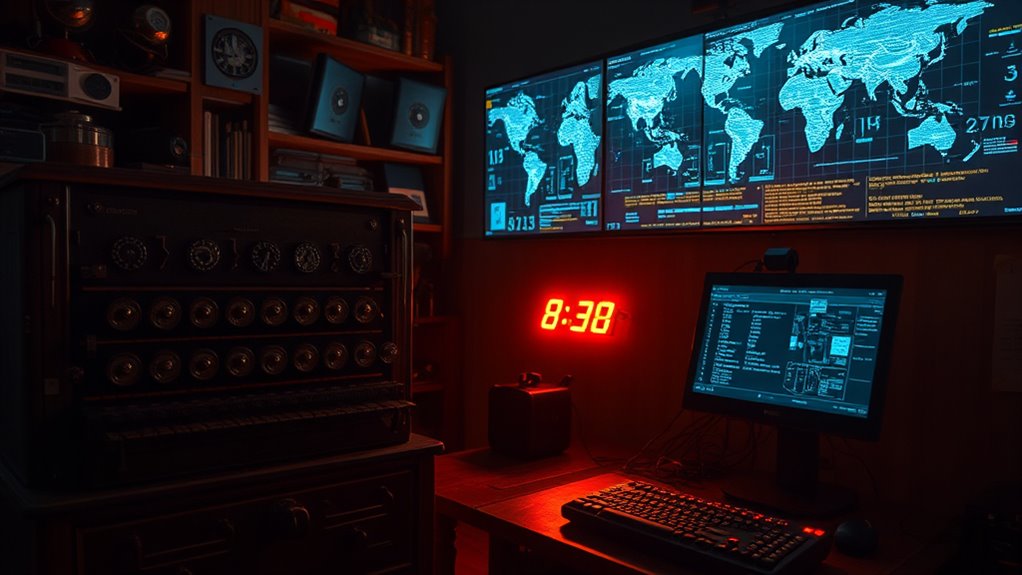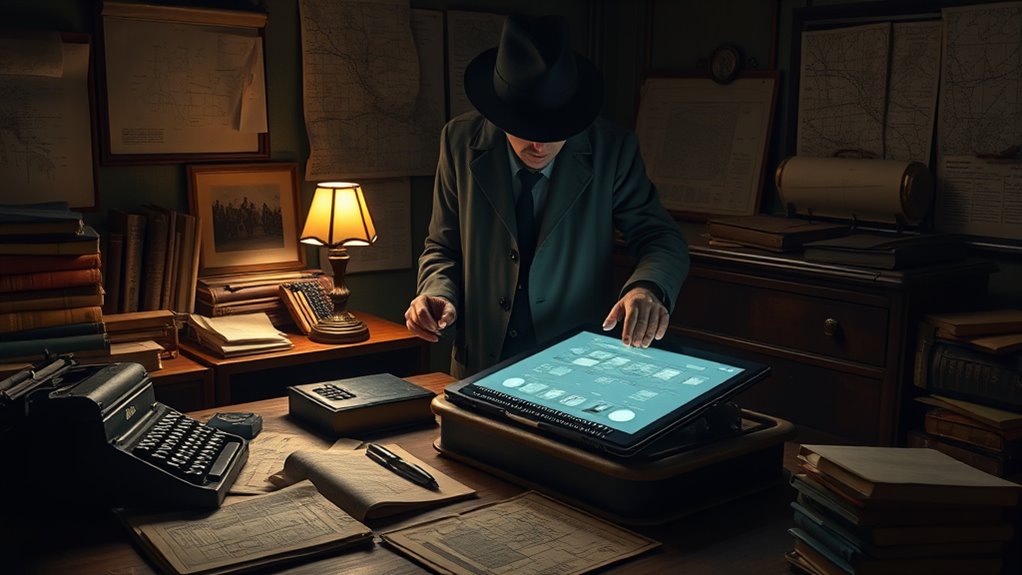From Enigma’s code-breaking to AI-driven analysis, espionage has drastically evolved thanks to technological advances. You’ve moved from physical disguises, covert meetings, and secret messages to digital encryption, cyber hacking, and automated surveillance tools. Drones, satellites, and cyber tactics now enable instant, detailed intelligence gathering. If you want to understand how these innovations shape modern spying and what’s next, keep exploring this fascinating transformation.
Key Takeaways
- Cryptography evolved from simple cipher devices like Enigma to advanced digital encryption protecting modern espionage communications.
- Surveillance technology shifted from physical methods to high-tech tools such as satellites, drones, and electronic interception systems.
- Cyber espionage enables remote hacking, data extraction, and manipulation, reducing reliance on physical infiltration.
- Artificial intelligence automates data analysis, pattern recognition, and threat prediction, enhancing espionage efficiency.
- Continuous technological innovations, including AI, secure communication, and cyber tools, have transformed espionage from manual to digital intelligence operations.

How has technology transformed espionage over the years? It’s a question that’s as fascinating as it is complex. In the past, spies relied heavily on physical methods—hidden messages, covert meetings, and disguises. But today, technology has revolutionized the game, making espionage faster, more precise, and often more covert. With cryptography breakthroughs, you can now encode messages so complex that intercepting them becomes nearly impossible without the right keys. These advances in cryptography have allowed intelligence agencies to securely communicate across borders, ensuring their plans stay hidden from adversaries. You see, the evolution of cryptography isn’t just about making messages unreadable; it’s about creating a digital fortress that protects sensitive information from cyber threats and interception. This has opened up new avenues for clandestine operations, allowing agents to exchange intel without fear of exposure.
Alongside cryptography breakthroughs, surveillance innovations have taken center stage. Modern technology enables you to monitor targets with a level of detail that was unimaginable a few decades ago. Drones equipped with high-resolution cameras can track movements from miles away, while satellite imagery provides real-time insights into strategic locations. Electronic surveillance tools, like wiretapping and data interception, are now more sophisticated, capable of tapping into communication networks seamlessly. These surveillance innovations give intelligence agencies a significant edge—they can gather intel covertly, analyze patterns, and even predict future actions. For you, it means that no conversation or digital footprint is too small to escape scrutiny. Every email, call, or online activity becomes a piece of the puzzle in understanding and countering threats. Additionally, the development of high-speed communication networks has further accelerated the pace and scope of intelligence operations, enabling near-instantaneous data transfer and analysis. The ongoing development of automated analysis tools continues to enhance the speed and accuracy of intelligence interpretation. Moreover, the integration of cybersecurity measures is crucial in defending against counterintelligence efforts and hacking attempts. As digital communications become more encrypted, the challenge of decoding and interpreting encrypted data has become a critical focus for intelligence agencies. Advances in machine learning algorithms are now also being leveraged to identify patterns and anomalies more efficiently, further transforming surveillance capabilities.
The integration of these technological advancements has also led to a shift in espionage tactics. No longer are spies solely relying on physical infiltration; instead, cyber espionage plays a critical role. You can now hack into secure systems, extract valuable data, and even manipulate information—all remotely. This digital warfare has lowered the barriers to conducting espionage, making it accessible to more actors, including state-sponsored agencies, hackers, and even non-state actors. The constant evolution of technology keeps pushing the boundaries of what’s possible in intelligence gathering. From the days of the Enigma machine to today’s AI-driven analysis, each breakthrough builds on the last, creating a dynamic landscape where espionage is increasingly digital, encrypted, and automated. As you can see, technology’s role in espionage continues to grow, shaping a future where information dominance is more critical than ever.
Frequently Asked Questions
How Did Early Spies Decode Encrypted Messages Before Modern Computers?
Before modern computers, you relied on manual cipher techniques and steganographic methods to decode messages. You’d study encrypted texts carefully, looking for patterns and clues, then use pencil and paper to test possible cipher keys. Steganographic techniques involved hiding messages within images or other media, which you’d uncover through careful analysis. This manual process required patience, skill, and intuition, as you worked through each message step-by-step without digital tools.
What Role Did Cryptography Play in Ancient Espionage Practices?
Imagine cryptography as a hidden dance, where secret ciphers are the steps you must uncover. In ancient espionage, you play the role of a code breaker, deciphering messages concealed behind symbols and patterns. These secret ciphers protected essential intelligence, ensuring your enemies’ secrets stayed locked away. Cryptography, then, was your shield and sword, shaping strategies and securing communications long before modern technology transformed espionage.
Were There Any Secret Espionage Technologies Used During World War I?
During World War I, secret espionage technologies included innovative cryptographic breakthroughs that improved covert communication. You’d find encrypted messages, coded signals, and secret inks used to relay essential information without interception. These advancements allowed spies to transmit intelligence securely, giving their nations a strategic edge. While less sophisticated than later Enigma machines, these methods marked significant progress in wartime espionage, emphasizing the importance of secure communication in warfare.
How Have Espionage Tools Impacted International Diplomacy Historically?
You see, espionage tools like cyber warfare have dramatically impacted international diplomacy by revealing secrets and shifting power dynamics. These technologies influence diplomatic negotiations, often giving nations an advantage or forcing transparency. You might not realize it, but advancements in espionage can escalate conflicts or foster cooperation, depending on how they’re used. Overall, these tools shape relationships and strategies, making diplomacy more complex and intertwined with technological capabilities.
What Ethical Concerns Arise From the Use of AI in Modern Spying?
Imagine AI as a double-edged sword, granting incredible insight but risking your privacy and fairness. As you rely on AI for spying, you face ethical concerns like privacy breaches and bias, which can distort truth and harm innocent lives. This technology’s power demands careful oversight, ensuring it doesn’t undermine trust or perpetuate unfairness. You must balance innovation with responsibility to uphold ethical standards in modern espionage.
Conclusion
You might think technology makes espionage less exciting or too predictable. But, in reality, it’s constantly evolving, pushing you to stay smarter and more adaptable. From deciphering codes to hacking into systems, modern espionage keeps you on your toes. Embracing these advances doesn’t mean losing the human touch—it’s about leveraging innovation to stay ahead. So, don’t fear the change; see it as your greatest tool in the game of secrets.









